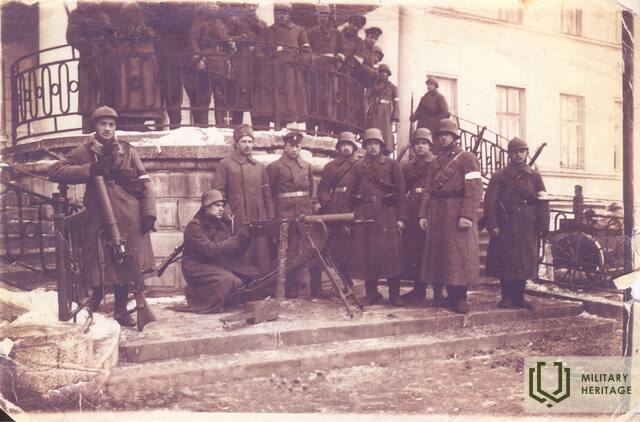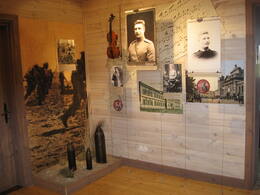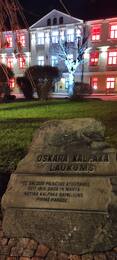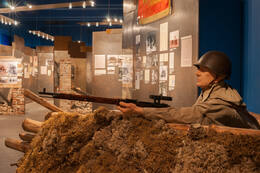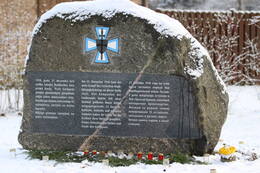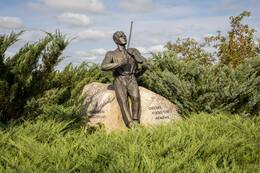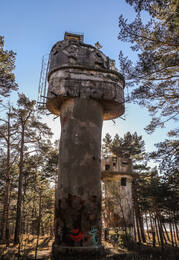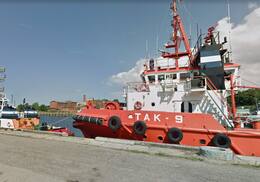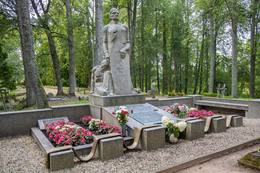Latvijos laikinosios vyriausybės ginkluotosios pajėgos
I Nepriklausomybės karai
Politiškai ir ideologiškai lojalios Latvijos laikinajai vyriausybei Latvijos vidaus gvardijoje ir Estijos armijoje karinės formacijos per Latvijos nepriklausomybės karą nuo 1918 m. lapkričio 18 d. iki 1919 m. liepos 10 d.
Latvijos laikinosios vyriausybės ginkluotosios pajėgos buvo suformuotos decentralizuotai per maždaug šešis mėnesius, esant aplinkybėms, kai Latvijos laikinoji vyriausybė negalėjo visiškai kontroliuoti Latvijos teritorijos. Jį daugiausia sudarė savanoriai ir mobilizuoti gyventojai iš Latvijos ir Estijos teritorijų. Laikinosios vyriausybės ginkluotąsias pajėgas sudarė Pietų Latvijos brigada, Šiaurės Latvijos brigada ir partizanų daliniai arba „žaliosios armijos“, taip pat komendanto ir paramos tarnybos. Iki 1919 04 16 Latvijos laikinosios vyriausybės ginkluotosios pajėgos taip pat buvo laikomos vokiečių Landesvero daliniais. Siekiant išskirti ideologinę Landesvero ginkluotųjų dalinių priklausomybę, literatūroje vartojamas terminas nacionalinės kariuomenės.
Daugiau informacijos šaltinių
https://enciklopedija.lv/ skyrelis „Latvijos laikinosios vyriausybės ginkluotosios pajėgos, 1918–1919“
Susijusios vietos
Oskaro Kalpako muziejus ir memorialinė vieta „Airītes“
Oskaro Kalpako muziejus ir memorialinė vieta „Airītes“ yra tarp Saldaus ir Skrundos, netoli greitkelio A9. Parodoje pateikiama išsami informacija apie pulkininką Oskarą Kalpaką ir jo batalioną, taip pat pristatoma Latvijos nacionalinės armijos ir memorialinės vietos „Airītes“ istorija. Parodoje pulkininką Oskarą Kalpaką pristatoma kaip asmenybę, kaip karį ir kaip kovotoją už Latvijos nepriklausomybę. Parodoje taip pat yra garso įrašų latvių, anglų ir vokiečių kalbomis. Juose pabrėžiama 1918/1919 m. istorinių įvykių svarba saugant Latvijos valstybingumą. Muziejaus pastatas yra restauruotas.
Įėjimas nemokamas; ekskursija su gidu – mokama. Komplekse yra poilsio zona, parkas, kliūčių ruožas, galima lankyti įvairius užsiėmimus, yra seminarų salė iki 30 žmonių.
Memorial stone in Oskaras Kalpaka Square in Saldus
O. Kalpakos aikštė yra pačiame Saldaus centre, Lielā ir Striķu gatvių sankryžoje.
Buvusi turgaus aikštė šiandien yra mėgstama Saldaus gyventojų ir lankytojų poilsio vieta, kurioje rengiami koncertai, minėjimai ir šventės. 1919 m. kovo 10 d. Saldaus tapo pirmuoju Latvijos miestu, kurį išlaisvino pulkininko Oskaro Kalpako batalionas.
1919 m. kovo 14 d. aikštėje įvyko pirmasis Latvijos atskirojo bataliono paradas, o 1992 m., pulkininko Kalpako garbei, aikštė buvo pavadinta jo vardu.
Latvijos karo muziejus
Latvijos karo muziejus yra įsikūręs senamiestyje, netoli Laisvės paminklo, istoriniame gynybos pastate, vadinamame „Parako bokštu“. Muziejuje yra 11 eksponatų. Čia eksponuojami įvairūs ginklai, dokumentai, uniformos, apdovanojimai, ženkleliai ir kiti daiktai, pasakojantys apie kasdienį kareivio gyvenimą kare. Latvijos karo muziejus yra vienas seniausių muziejų Latvijoje. Jo ištakos siekia Pirmąjį pasaulinį karą. Muziejaus kolekciją daugiausia sudarė asmeniniai kareivių daiktai arba mūšio laukuose rasti daiktai. Latvijai atgavus nepriklausomybę, pagrindinis muziejaus tikslas tapo sukurti ekspoziciją apie Latvijos karo istoriją ir aktyvų gyventojų vaidmenį saugant savo žemę. 1937 m. muziejus buvo išplėstas ir techniškai buvo vienas moderniausių tuo metu Europoje. Parako bokštas buvo vienas iš Rygos įtvirtinimų bokštų. Kai kurie įrodymai siekia 1330 m., kai jis buvo minimas kaip „Smėlio bokštas“. Bokštas buvo sugriautas 1621 m., kai Rygą apgulė Švedijos armija. Tačiau 1650 m. buvo pastatytas naujas bokštas parakui ir ginklams laikyti. Nugriovus miesto įtvirtinimus, Parako bokštas išlieka vienu svarbiausių Rygos gynybos sistemos įrodymų.
Monument to the first battle for Latvia's independence
Atroadas, Inčukalns, Atmodas Street 2.
On July 3, 2016, a monument to the first battle for Latvia's independence, dedicated to the Latvian National Guard (Die Lettländische Landeswehr), was unveiled. sides. Eižens Upmanis, the chairman of the Brothers' Cemetery Committee, concluded at the time that this could be the historically first monument to the combined Latvian and Baltic forces in the battle memorials outside the cemetery. At that time, Lieutenant Colonel Oskars Kalpaks was appointed commander of the Latvian units of the Latvian National Guard or Landesver, from whose units the later Latvian army grew and formed during the Freedom Fights.
In 1918, the entire territory of present-day Latvia had fallen into the hands of the German Empire and its troops. However, at the end of the summer and autumn of 1918, the situation began to end badly for Germany, and it was clear that it was only a matter of time before Germany would be forced to concede defeat in World War I. The Russian Empire, which included Latvia before World War I, had ceased to exist earlier, with the revolutions of February and October 1917. On November 18, 1918, the Republic of Latvia was proclaimed. After the ceasefire with the Entente on November 11, 1918, the German army, which was on the territory of Latvia, was no longer motivated for further warfare, and most of its soldiers simply wanted to return home.
Under such circumstances, it was clear that Latvia's defense depended primarily on the national guard formed by the people of Latvia. Initially, due to their education and relatively greater ability to self-organize, the greatest initiative in creating such a national guard was shown by the Baltic Germans living in Latvia. Russian soldiers also joined the National Guard. In order to ensure the supply of the National Guard with uniforms, weapons and other necessary resources, on December 7, 1918, the Provisional Government of Latvia entered into an agreement with the German representative August Vinnig, providing for the provision of the National Guard from the German army reserves in Latvia. This agreement stated, among other things, that the National Guard, officially known as the Latvian National Guard or in German, the die Lettländische Landeswehr, would be the armed forces of the Republic of Latvia.
Two soldiers of the Latvian Red Rifle Regiment (ie approximately 2,000 to 3,000 soldiers) who had previously experienced in World War I and the Russian Civil War faced the Latvian National Guard. Despite the experience and numerical superiority of the Red Army, the Latvian National Guard held Inčukalns for two days in fierce fighting, until finally, in the evening of January 1, 1919, to avoid siege, was forced to retire, losing 43 dead and several wounded, most of whom was taken captive by the Bolsheviks, where they were killed or died of starvation or disease.
Author: Artis Buks. Material: Boulder. The monument is made of large monolithic stone, which was found in Rolls near Jelgava.
The birthplace of Colonel Oskars Kalpaks “Liepsalas” and the final resting place in Visagals cemetery
The Colonel Oskars Kalpaks family memorial in Liepsalas is located in the area between Madona and Lake Lubāns. Liepsalas is Kalpaks’ childhood home. The memorial site was established here in 1997 based on the ideas and using the resources of the colonel’s niece, Ārija Kalpaks-Grundmane (1922-2006). The site consists of various environmental objects and stone sculptures with a symbolic meaning, signifying Latvian ethical and patriotic values. The largest building houses an exhibit dedicated to the history of the Latvian War of Independence and the 22 years of Latvian freedom (1918-1940). Located in the Visagals graveyard, the monument to Oskars Kalpaks, created by Kārlis Zāle and Arnolds Dzirkals, was unveiled in 1927. The monument consists of a composition of three figures, in the centre of which is an ancient Latvian warrior holding a shield and a sword, with a falling soldier on each side. Placed obliquely on a granite base, a bronze plaque at the foot of the sculptural group contains engraved text, including a poem, dedicated to Kalpaks, by Edvards Virza. Oskars Kalpaks died on 6 March 1919 near Airītes, by the road from Skrunda to Saldus.
Karosta, the Military port of Liepāja (tour)
The Karosta is the largest historical military territory in the Baltics and occupies almost one third of the entire territory of Liepāja. The Karosta is a unique compound of military and fortification buildings on the shores of the Baltic Sea with a special meaning in the history and architecture of Latvia and the world. The Karosta features such military heritage sites as the North Pier and forts, the Redan, Karosta Prison, Karosta Water Tower, St. Nicholas Orthodox Maritime Cathedral, Oskars Kalpaks Bridge and others.
The real berth of the ship "Saratov".
The real berth of the ship "Saratov" is located in Liepāja, Vecā ostmala 59 near the boat docks, but the memorial is located in the immediate vicinity of the special economic zone of Liepaja.
Built in 1888 in Copenhagen in the shipyard "Buvmeistar & Wain" under the name "Leopold II". 1911. In 2010, it was bought by the joint-stock company Russian North-West Shipping and renamed "Saratov", Latvian Aleksandrs Remes became the ship's captain.
In May 1915, when Liepaja was occupied by German troops, "Saratov" was in the port in a damaged condition.
On January 10, 1919, the steamship "Saratov" was taken over by the Provisional Government of Latvia. From April 1919 to July 1919 on the ship "Saratov" after "16. of the April coup" was the Provisional Government led by K. Ulmanis, which was forced to save itself under the protection of the Allied fleet.
On July 8, 1919, after the Provisional Government of K. Ulmanis was brought to Riga, the steamer was used in traffic between Riga, Ventspils and Liepāja.
According to the terms of the peace treaty of August 11, 1920 between Latvia and Soviet Russia, the steamer "Saratov" had to be returned to the Soviet side. On January 2, 1923, the steamers were handed over to the representative of Soviet Russia. On January 15, 1923, the steamer "Saratov" perished near Akmeņraga.
In 1936, the Maritime Department of Latvia sold the shipwreck to a company, which salvaged it and delivered it for scrap to the Liepāja Shipyard.
The last resting place of Colonel Oskars Kalpaks
Located in Visagala Cemetery, Madona district
On July 10, 1927, a monument made by Kārlis Zāle and Arnolds Dzirkaļs was unveiled to Oskars Kalpaks - a composition of three figures, in the center of which is an ancient Latvian warrior with a shield and a sword in his hand, but on both sides is a wielding soldier. At the foot of the sculptural group, a bronze plaque is placed on the granite base, with a text engraved on it, which also includes a poem by Edward Virza dedicated to Kalpak.
Oskars Kalpaks fell in 1919. On March 6, near "Airīte", on the side of Skrunda - Saldus road, on September 18, his remains were transferred from the northern cemetery of Liepāja to the family cemetery in Visagala.
The monument was unveiled by General J. Balodis, Chairman of the Monument Committee of Colonel O. Kalpaks, with the participation of the then President G. Zemgale, Prime Minister M. Skujenieks, Speaker of the Saeima P. Kalniņš, Minister of War R. Bangerskim and K. Ulmanis. The foundation stone of the monument was laid on June 19, 1925. The stone for the monument is taken from the colonel's native house in Siena swamp, O. Kalpaks loved to play the violin on this stone as a child.
Susijusi istorija
Paskutinis pulkininko Kalpako mūšis prie Airytės
Pulkininkas Kalpaks buvo gerbiamas veikėjas kariniuose sluoksniuose ir tikras patriotas. Būtent patriotizmo dvasia ir nelemtas atsitiktinumas lėmė lemtingą jo ir vokiečių batalionų susidūrimą, kuris, deja, baigėsi pulkininko Kalpako žūtimi.
Estijos karinis jūrų laivynas padeda Latvijos pajėgoms Nepriklausomybės karo metu
Birželio 23 dieną estai švenčia Pergalės dieną, pažymėdami bendrą Latvijos ir Estijos pergalę Cėsių mūšyje. Ir šioje pergalėje nemažą vaidmenį suvaidino Estijos karinis jūrų laivynas, kuris šiame Landesvero kare, kaip jį vadina estai, savo drąsiais veiksmais ir tikslia patrankų ugnimi Dauguvos žiotyse kėlė grėsmę pagrindiniams vokiečių pajėgų tiekimo maršrutams per Dauguvą visai netoli Rygos.
Jānis Lapiņš ir pirmasis Latvijos raudonos, baltos ir raudonos vėliavos projektas
Latvijos nacionalinė vėliava buvo sukurta Pirmojo pasaulinio karo metais. 1915 m., kurdami latvių šaulių batalionų vėliavas, kai kurie menininkai vėliavų dizainui pasiūlė raudoną, baltą ir raudoną spalvas. Švietėjo ir žurnalisto Jānio Lapinio sukurtą raudonai baltai raudoną vėliavą 1916 m. antroje pusėje pagamino jo mokinė, Valmieros pabėgėlių prieglaudos mokytoja Marianna Straumane. Tai pirmoji žinoma ir realiai pagaminta Latvijos nacionalinė vėliava, išlikusi iki šių dienų.
Oskaro Kalpako bataliono mūšis ties Lielauce
Sausio 15-osios naktį Kalpakų batalionas kovėsi pirmą mūšį ties Lielauce, atremdamas raudonųjų puolimą. Tai buvo pirmasis reikšmingas Kalpako bataliono mūšis, kai pergalė kariams suteikė ypač stiprų moralinį pastiprinimą.
Oskarui Kalpakui atminti
Oskaro Kalpako atminimas saugomas daug kur – tai liudija jo gimtasis Liepsalu namas, paminklas Visagalos kapinėse, atminimo renginiai ir gražūs Kovo 6-osios koncertai, Meirānu Kalpako pagrindinė mokykla, gatvės Lubanoje, Madonoje ir kituose miestuose ir toliau. Bet šiame straipsnyje – apie Oskaro Kalpako atminimo išsaugojimą gimtinėje XX amžiaus 2–3 dešimtmetyje. metų.
Apie pirmąjį Latvijos kariuomenės vadą Dāvidą Sīmansoną
Knygoje „Latvijos kariuomenės vadai“ esantys rašiniai įtikina, kad istorijai didelę įtaką daro konkretūs asmenys. Nors svarbiausių istorinių įvykių epicentre jie buvo neilgai, tikri Latvijos patriotai, turėdami turtingą karinę patirtį, sugebėjo daug nuveikti formuojant ir stiprinant Latvijos kariuomenę bei istorinių įvykių lūžio momentuose.
Ši istorija pasakoja apie pirmąjį Latvijos kariuomenės vadą Dāvidą Sīmansoną (1859-1933).
Šiaurės Latgalos išvadavimas iš bolševikų
1918 m. gruodžio 1 d. Raudonosios armijos daliniai, paremti Raudonųjų šaulių daliniais, įsiveržė į Latvijos teritoriją. Siekdami apsaugoti savo namus, šeimas, gimtuosius rajonus, pabėgti nuo siaubo, Balvi apylinkių vyrai griebėsi ginklo ir ėjo į miškus, pradėjo kurtis pirmosios „žaliosios“ grupės. 1919 m. pavasarį, kai buvo paskelbta mobilizacija, daugybei Balvų apylinkių vyrų kovoti sovietinėje Latvijos armijoje atrodė nepriimtini ir jie prisijungė prie „žaliųjų“ grupuočių. Susikūrė Balvų, Silakrogo, Rugėjų, Teterių-Dūrupės ir Liepnos grupės. „Žaliųjų“ grupių veikla Balvių apylinkėse suaktyvėjo 1919 metų kovo mėnesį.
Artūro Ozolo prisiminimai apie laivą „Saratov“
Artūrs Ozols baigė Rygos politechnikumą ir tarnavo karinio jūrų laivyno karininku (midshipman) bei inžinieriumi Rusijos Juodosios jūros laivyne karo laive Panteleimon. Latvijos išsivadavimo kovų metu įstojo į Mokinių kuopą. Liepojoje pradėjo eksploatuoti laivą „Saratov“. Artūro Ozolo prisiminimai apie laivą „Saratov“ išspausdinti mėnraštyje „Dauagavos Vanagi“.
Akmenrago švyturys ir seklumas – vienos didžiausių laivų kapinių Baltijos jūroje
Būtent Akmensrago švyturio apylinkėse 1923 m. sausio 13 d. ant seklumos tragiškai užplaukė ir sudužo garlaivis Saratov , prie kurio prisiglaudė K. Ulmanio vadovaujama laikinoji vyriausybė, kuriant nepriklausomą Latvijos valstybę.
Vilio Narkevičiaus kovinės veiklos aprašymas 1919 m. lapkričio 6 d
Būrio vado, vado leitenanto Juliaus Rozentalio Vilio Narkevičiaus kovinės veiklos aprašas, 1921 m. lapkričio 3 d.




